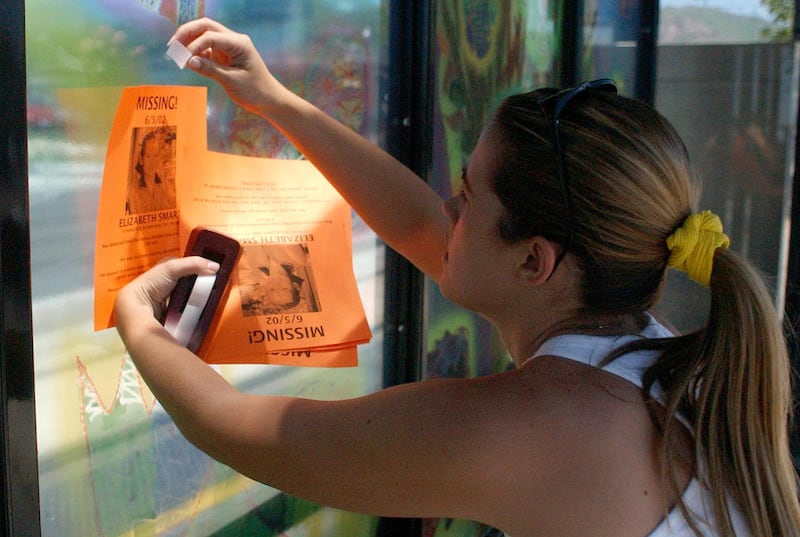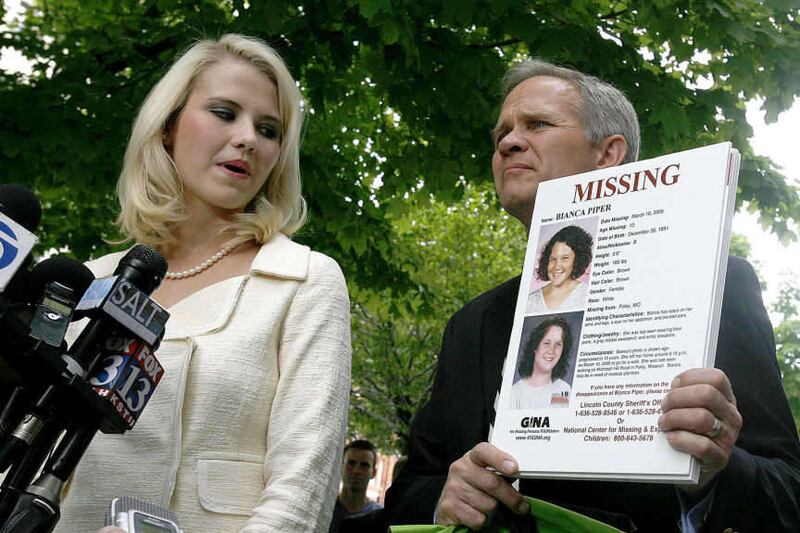Across its 175-year history, the Deseret News has chronicled the highs and lows of the Beehive State, including numerous notorious Utah crimes. The state has witnessed everything from Butch Cassidy’s decades-long string of robberies to Mark Hofmann’s elaborate forgeries. Incidents such as the Hi-Fi murders, the Trolley Square shooting and the Elizabeth Smart kidnapping captivated local and international attention, and the Deseret News has been there, reporting on the misdeeds and tragedies, all along the way.
Tragedy at Mountain Meadows
In 1857, 120 members of a wagon train traveling from Arkansas to California were killed in southwestern Utah by a group of local church members and some members of the Paiute Indian tribe who had been recruited for the attack in the earliest mass tragedy in the state.
In 2007, The Church of Jesus Christ of Latter-day Saints issued a long-awaited apology for the massacre when Elder Henry B. Eyring of the Quorum of the Twelve Apostles read the church’s statement at a memorial ceremony at the gravesite of some of the massacre victims at Mountain Meadows, about 35 miles northwest of St. George.
“We express profound regret for the massacre carried out in this valley 150 years ago today, and for the undue and untold suffering experienced by the victims then and by their relatives to the present time,” Elder Eyring said.
“A separate expression of regret is owed the Paiute people who have unjustly borne for too long the principal blame for what occurred during the massacre,” he said.
“Although the extent of their involvement is disputed, it is believed they would not have participated without the direction and stimulus provided by local church leaders and members.”
Seventeen children survived the massacre that culminated a four-day standoff between the attackers and the travelers, who were mostly from Arkansas.
Gentleman bandit?
Most readers will likely not immediately recognize the name Robert LeRoy Parker, born on April 13, 1866, to a poor pioneer family in Beaver, Utah Territory.
But almost everyone is familiar with Parker’s “working” name — Butch Cassidy.

Featured in numerous news stories published by the Deseret News from the late 1800s into the early 1900s, Cassidy was one of Utah’s earliest and most well-known criminals. He earned that notoriety as a bank robber who traveled the West in search of targets, stealing upward of $70,000 at a time. A recent Deseret News story notes Cassidy robbed banks and trains in the Intermountain West, and was one of the leaders of the Hole-in-the-Wall Gang and the Wild Bunch.
Parker was the oldest of 13 children in a poor Latter-day Saint family. The family soon moved to the Circleville area of Piute County, and what is believed to be his boyhood home is still standing.

Despite his criminal activity, Cassidy was not known to be violent and was actually well liked by the American public, who enjoyed reading about his exploits in the newspaper.
The early deeds of a serial killer
Gary Ridgway, the “Green River Killer,” is the most prolific serial murderer in U.S. history. Convicted of 49 killings, he may be responsible for over 90. His chilling last words, “I killed so many women I have a hard time keeping them straight,” reveal his lack of remorse.

Ridgway’s disturbing history began in Utah. At just 14, he attempted to murder a 6-year-old boy by stabbing him.
Spanning three decades, his confirmed killings started in 1973, though it’s suspected he began earlier. He evaded justice until 2001, when DNA evidence led to his capture. Serving a life sentence, Ridgway remains imprisoned.

The Hi-Fi murders
On April 22, 1974, three airmen stationed at Hill Air Force Base — Dale Pierre, William Andrews and Keith Roberts — targeted The Hi-Fi Shop in Ogden for a robbery. Pierre and Andrews entered the store at closing time, while Roberts remained outside in the getaway van.
Inside, they took five hostages: employees Stanley Walker and Michelle Ansley; Courtney Naisbitt, who had stopped by to visit Walker; and later, Orren Walker and Carol Naisbitt, who arrived separately looking for their missing children. The hostages were taken to the basement, where they were brutally tortured. Andrews forced them to ingest Drano, and Pierre raped Ansley. When the poison did not kill quickly, Pierre shot each victim.
Ansley, Stanley Walker, and Carol Naisbitt died from their injuries. Courtney Naisbitt suffered permanent brain damage but survived after a lengthy hospitalization. Orren Walker also survived, despite severe injuries including chemical burns and a punctured eardrum.
The crime was discovered hours later by family members. A breakthrough came when two teens found victims’ belongings in a dumpster at Hill Air Force Base, leading police to Pierre, Andrews and Roberts. All three were arrested and tried together. Roberts, uninvolved in the killings, was convicted of robbery and paroled in 1987. Pierre and Andrews were each convicted of murder and executed by lethal injection in 1987 and 1992, respectively.

A grim distinction
Convicted murderer Gary Gilmore’s 1977 execution was the first in the U.S. following a landmark 1976 Supreme Court decision that permitted states to reinstate capital punishment after it had been banned.

Gilmore was shot to death by a firing squad on Jan. 17, 1977, after being convicted of murdering two young Utah County men: motel manager Ben Bushnell and gas station attendant Max Jensen.
Arriving in Provo in 1976 after spending over two decades in various Oregon prisons for offenses ranging from drunk driving to armed robbery, Gilmore’s time in Utah took a dark turn just four months later. He committed the two separate murders during the commission of robberies.
Opting for death by firing squad at the Utah State Prison, Gilmore’s infamy grew after his murders. Reportedly, his last words before execution were, “Let’s do it.”

A mother’s son — and hitman
On July 23, 1978, 17-year-old Marc Schreuder walked into a Salt Lake City warehouse and shot Franklin Bradshaw in the back of the head.
Police would later discover a bizarre family plot behind the killing, revealing that Schreuder was Bradshaw’s grandson and the killing was ordered by his mother, Frances B. Schreuder. And the scheme behind the murder was one motivated by money and greed.
According to court documents, Frances Schreuder and her father, a wealthy Utah businessman, frequently argued over financial issues and the daughter was worried she’d be cut off from her father’s estate. Frances Schreuder was a New York socialite who reportedly spent tens of thousands of dollars on Tiffany’s jewelry and sat on the board of the New York Ballet.
At his mother’s 1983 trial, Marc Schreuder testified that he begged her not to make him kill his grandfather, but she threatened to turn her back on him if he didn’t. He said she told him: “Look, Marc, it is not really killing. It is the right thing for us to do.”

Convicted of second-degree murder in 1982, Marc Schreuder spent 12 years in the Utah State Prison before being paroled. Frances Schreuder served 13 years for capital murder.
More than a master forger
Mark Hofmann was a master forger who created and sold hundreds of counterfeited documents before he eventually killed two people in an attempt to conceal his deception. He notably duped numerous academic scholars, the FBI, experts at the Library of Congress and even some leaders of The Church of Jesus Christ of Latter-day Saints.
On Oct. 15, 1985, two motion-sensitive explosive devices made by Hofmann detonated to horrific consequences.
The first bomb exploded a few minutes after 8 a.m. that day, killing Steve Christensen when he reached down to pick up a package in front of his office at the Judge Building in downtown Salt Lake City. The second bomb exploded just moments later, killing Holladay resident Kathy Sheets when she picked up a package in front of her home, though Hofmann was targeting her husband with the device.

Hofmann was found guilty in 1988 and remains in prison. His story was made more famous by the Netflix documentary, “Murder Among the Mormons.”

A web posting by The Church of Jesus Christ of Latter-day Saints notes the Hofmann deceptions raised the bar for review of potential historical documents related to the church.
“Church historians and archivists have also exercised increased vigilance in corroborating claims of document provenance and historical context with other evidence. The publication and digitization of Joseph Smith’s papers and many other important document collections has helped broaden the base from which to evaluate new discoveries.”

An unthinkable incident at a historic landmark
On Feb. 12, 2007, a man with a shotgun ran into Salt Lake City’s Trolley Square and fired multiple shots, killing five people and hitting multiple other victims before he was killed, according to Deseret News coverage of the event.
As the story unfolded, “Salt Lake City Police Detective Robin Snyder confirmed the shooter was dead and that several people were in critical condition at area hospitals,” according to the coverage, written by a team of reporters on the scene and in the newsroom.
Media coverage of the mass shooting at a well-known landmark shook Salt Lake City. Trolley Square, once the hub of Salt Lake City’s busy street car system, was converted into a shopping mall in the early 1970s.
The Elizabeth Smart kidnapping
On June 5, 2002, 14-year-old Elizabeth Smart was abducted at knifepoint from her bedroom in Salt Lake City while her family slept. Her kidnapper, Brian David Mitchell, a self-proclaimed prophet who called himself “Emmanuel,” had previously worked briefly at the Smart home as a handyman. He and his accomplice, Wanda Barzee, held Smart captive for nine months, moving her between remote mountain camps and California, where she endured constant abuse and manipulation.

Despite massive media attention and a nationwide search, Smart remained missing until March 12, 2003, when she was spotted in Sandy by members of the public who recognized her from news reports. She was safely returned to her family the same day. Mitchell and Barzee were arrested and later convicted.

The case shocked the nation and highlighted gaps in the way missing children cases were handled. Smart went on to become a powerful advocate for child safety and recovery, founding the Elizabeth Smart Foundation and working to support victims of abuse and abduction.



